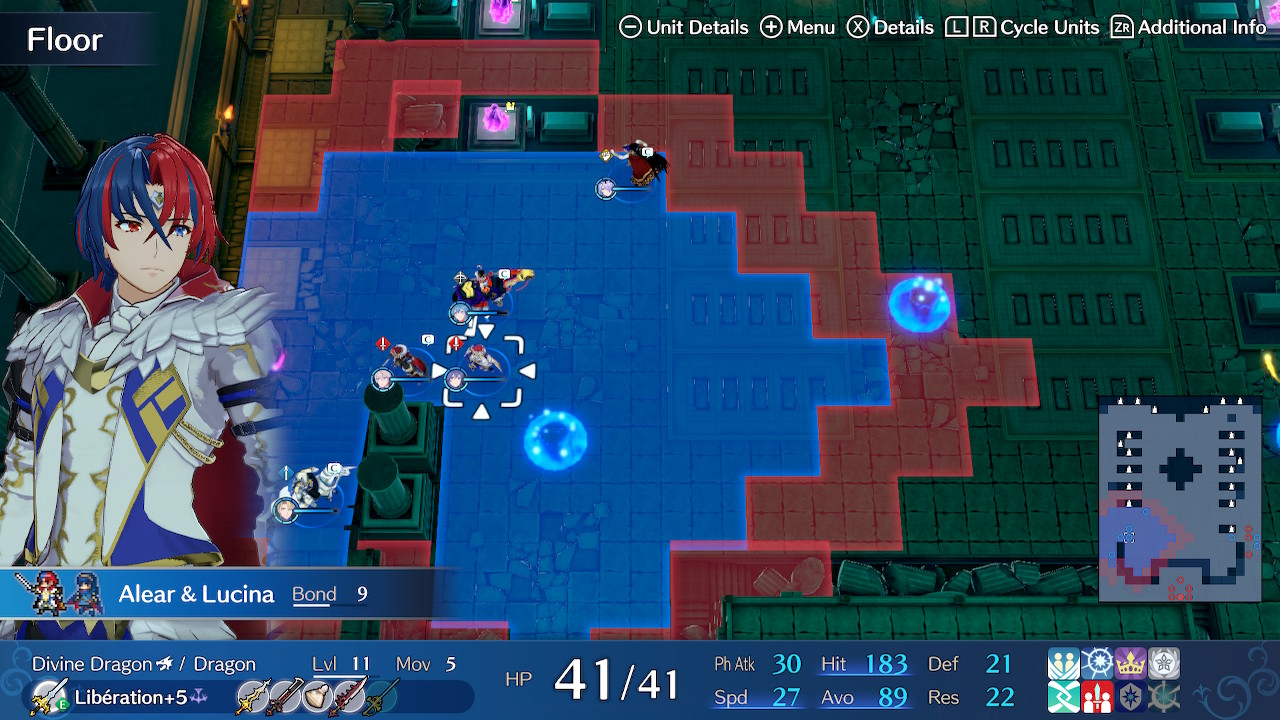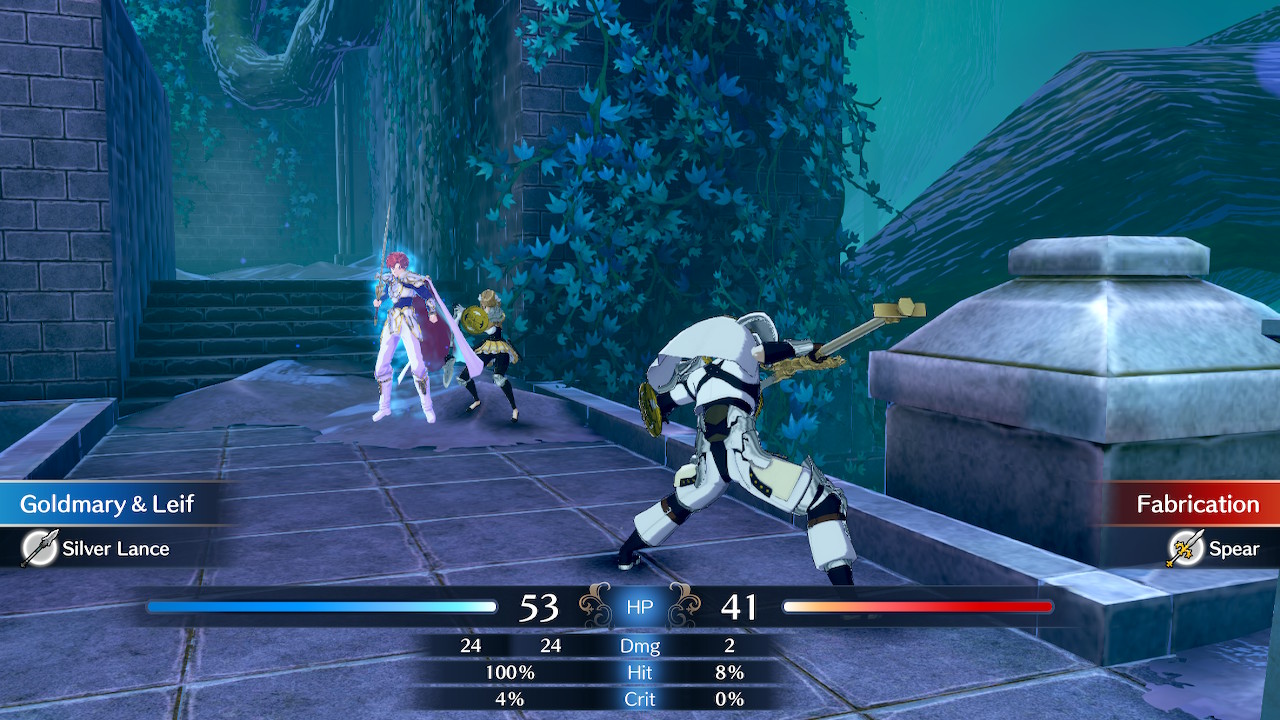Search
[{{{type}}}] {{{reason}}}
{{/data.error.root_cause}}{{{_source.title}}} {{#_source.showPrice}} {{{_source.displayPrice}}} {{/_source.showPrice}}
{{#_source.showLink}} {{/_source.showLink}} {{#_source.showDate}}{{{_source.displayDate}}}
{{/_source.showDate}}{{{_source.description}}}
{{#_source.additionalInfo}}{{#_source.additionalFields}} {{#title}} {{{label}}}: {{{title}}} {{/title}} {{/_source.additionalFields}}
{{/_source.additionalInfo}}- Details
- Category: Switch
- By Tyler Ferguson
- Hits: 2931
Fire Emblem Engage (Switch)

Fire Emblem Engage
Developed By: Intelligent Systems
Published By: Nintendo
Released: January 20, 2023
Available On: Switch
Genre: SRPG
ESRB Rating: T for Fantasy Violence, Mild Suggestive Themes, Mild Language
Number of Players: 1 offline
Price: $59.99
(Amazon Affiliate Link)
Despite being around since the NES days, Fire Emblem has never managed to achieve the popularity of Nintendo’s other series. In fact, Fire Emblem was nearly discontinued before its sudden surge in popularity, which peaked with Three Houses. When the time came to make the next entry in the series, Intelligent Systems would surely use Three Houses’ many changes to the formula as a base, right?
Nope! Fire Emblem Engage throws out Three Houses’ overhauls in favor of a return to the 3DS era of Fire Emblem, both in its more simplistic story and its gameplay.
You walk in the shoes of the Divine Dragon (whose name and gender can be customized), a humanoid dragon that is worshiped as a deity. You have just awoken from a 1,000-year slumber, and you soon encounter the zombie-like Corrupted. It is quickly revealed that these are the creations of the Fell Dragon, Sombron, who wishes to consume the world of Elyos. To accomplish this, he needs to collect the 12 Emblem Rings, rings that grant the power to summon Emblems, heroes from previous Fire Emblem games. It is your task to traverse the four nations of Elyos in order to claim the Emblem Rings for yourself and defeat Sombron.
I was not expecting a masterpiece in storytelling, and my expectations were not unfounded. While there were a few neat moments in the story, there was little that I haven’t seen a thousand times before. The dialogue between characters in the many story cutscenes and optional cutscenes usually ranges from uninteresting to irritating.
The concept of summoning previous characters feels like a missed opportunity. With the exception of Marth, Emblems barely have any relevance in the main story after their initial encounter, causing the story to feel like a generic “Collect all powerful items before the bad guys” plot, rather than allowing these classic characters to feel like actual characters. This is a shame, since the protagonist and the Emblems are among the few characters I liked.
Now, the story and writing may not be great, but how does the gameplay fare? I am glad to report that the gameplay is my favorite in the series. As it is a strategy role-playing game, Fire Emblem Engage plays like a game of Chess. At the start of a chapter, you deploy 8-12 units, which you move across the map to reach enemies, and eventually, the boss. When you place a unit adjacent to an enemy, you can attack it. Once all of your units have performed an action, you will have to watch the enemy units make their moves. While there are some scenarios where you just have to defeat every enemy, you usually have to make your way to a powerful boss. Defeating said boss will complete the chapter.
You’ll need to use units with a variety of classes. Archers can use bows to hit enemies from a distance, armored units are impervious to most physical weapons, and mages can use magic to penetrate their armor, just to name a few.
Returning from Fire Emblem Fates is the Weapon Triangle. With this system, units have an advantage based on one of three weapon types. The system goes as follows: Lances > Swords > Axes > Lances. This Rock, Paper, Scissors mechanic is more important than before, as attacking an enemy with a disadvantage will usually prevent it from counterattacking for one move. (This also applies to your units, forcing you to consider where you place your units and which weapons they have.)

Strong Points: Polished grid-based battles that are as fun as ever; new Emblems mechanic that mixes up gameplay
Weak Points: Uninteresting story with poor writing and missed potential
Moral Warnings: Violence with medieval weapons; heavy use of fantasy magic, along with some uses of rituals and invocations; optional fortune-telling; you control a godlike dragon; uses of curse words, such as h*ll, d*mn, b*****d; gross humor in the form of being able to gift horse manure; female characters with very revealing clothing; some sexual dialogue; one character who cross-dresses; some homosexuality; the game tries to avoid referring to you as male or female; optional ring (not unlike a wedding ring) you can give to anyone, regardless of age and gender
While preparing for the battle, you can equip your acquired Emblem Rings to any unit. By default, Emblems give powerful buffs and abilities, such as allowing a unit to hit an enemy one extra time or being able to move several spaces after attacking. At any point, you can have a unit engage with an Emblem. While in this state, which lasts for three turns before slowly recharging, your unit can use up to three weapons from the Emblem’s origin game. Your unit can also use one special move in this state, which can range from a powerful attack that increases in damage based on nearby units, to a healing ability that restores everyone’s health.
Two quality of life improvements worth mentioning are that units are now controlled directly on the grid (before, you moved a cursor and pressed A to move the unit), and that you can hold Y to quickly scroll through any menu. These minor improvements combined with the major changes to the combat, particularly the Emblems mechanic, make the gameplay the most engaging (pun not intended) of any recent Fire Emblem.
There are over 20 chapters in the main story, along with 15 side chapters. Most of these took me an hour, if not longer. Nearly every map is very fun to play. No map was frustratingly difficult, and few were too easy (at least on the normal difficulty, that is). My only issue with the map design is that too many maps rely on surprise enemy encounters, which became a little repetitive.
In between chapters, you can spend time in a hub world known as the Somniel. Here, you can interact with your units, along with preparing for battle by purchasing and upgrading weapons, improving the bonds between units and Emblems (which increases the boons they grant in battle), and managing units’ classes.
The most notable feature in the Somniel is the Tower of Trials. Here, you can play Tempest Trials, Relay Trials, and Outrealm Trials. In Tempest Trials, you play three maps consecutively. In Relay Trials, you can play on a map for several turns. After that, another player will be able to pick up from where you left off. Finally, Outrealm Trials have you placing obstacles on a simple rectangular map. The area you customize is then paired with another player’s map, and you must try to defeat their team of units. Note that the enemy team is controlled by AI, and that there is no true multiplayer in Fire Emblem Engage. Despite being the most interesting feature in the Somniel, I never used it beyond initially testing it out, as the battles are incredibly long with minuscule rewards.
The first discussions over Fire Emblem Engage back when it was leaked months ahead of its announcement were over its controversial visuals. While Fire Emblem has always been “anime,” Fire Emblem Engage goes for a much more generic anime style than its predecessors. (If I didn’t know this was Fire Emblem, I would have assumed I was looking at an update for Genshin Impact!) Despite this, Fire Emblem Engage’s visuals quickly grew on me. The colorful visuals look great during battles, and numerous pre-rendered cutscenes look amazing. The many cutscenes that aren’t pre-rendered unfortunately don’t look very good, but they are at least an improvement over Three Houses.
Unfortunately, the voice acting is a step down from Three Houses. While some voices are decent, such as the protagonist and Emblems (with the little dialogue they have), many characters’ voices became really grating.
Like most recent Fire Emblem games, the music tends to use orchestral instruments and choirs, along with electric guitars in some cases. The soundtrack is decent, but aside from a few exceptions, such as the very corny (yet catchy) vocal song that plays in an anime-style opening, I don’t find myself coming back to listen to it.

Higher is better
(10/10 is perfect)
Game Score - 82%
Gameplay - 17/20
Graphics - 7/10
Sound - 7/10
Stability - 5/5
Controls - 5/5
Morality Score - 57%
Violence - 6/10
Language - 5/10
Sexual Content - 2/10
Occult/Supernatural - 7/10
Cultural/Moral/Ethical – 8.5/10
It should come as no surprise that Fire Emblem Engage has an Expansion Pass. For an extra $30, you can unlock seven additional Emblems. These Emblems are useful, if a bit overpowered. All but one of them are unlocked in brand new side chapters. There is also a short side story, where you get transferred to—and attempt to save—a parallel of Elyos across six chapters. I initially enjoyed this more grim story, but I found it more tedious around halfway through. While this Expansion Pass is a better deal than Three Houses’, it still isn’t worth it.
As you would expect from an RPG, there is violence using medieval and fantasy weapons. Surprisingly, there isn’t a drop of blood, though there are still some violent cutscenes. In one scene, someone is eaten by a dragon, while in another, a character is stabbed.
There is heavy use of magic in Fire Emblem Engage. Along with it being an important weapon type during gameplay, it is used extensively in the story. It is generally fantastical, though. The first time you obtain an Emblem Ring, the protagonist says an invocation to summon the Emblem. Partway through the game, a fortune-teller joins your army. When he does so, a fortune-telling minigame is unlocked in the Somniel. I don’t know what its purpose is, as I made sure to avoid it during my playthrough. As mentioned before, you are known as the Divine Dragon, and characters treat you like a god.
There are occasional uses of words like h*ll, d*mn, and b*****d. When interacting with your units outside of battle, you can give them gifts you randomly obtain, including horse manure. (Don’t ask me why.)
Many female characters wear very revealing clothing, with one antagonist wearing barely anything to cover her breasts. There is some bizarre dialogue in which the same antagonist mentions wanting to have a child with the main villain. A male character who joins your army happens to dress like a girl. In the DLC story, a female character confesses to having feelings for the protagonist, regardless of the gender you picked for him/her. Speaking of gender, Fire Emblem Engage follows many recent Nintendo games in simply calling the protagonist’s gender “a form.”
Late in your journey, you can unlock an item called the Pact Ring. You can give this ring to anyone, regardless of age and gender, to unlock a special cutscene with that character. Despite the obvious connection to a wedding ring, most of these cutscenes aren’t romantic, at least in the English localization. (I’ve heard that in the original Japanese version, most of them were, however.)
Fire Emblem Engage has the best gameplay of any recent Fire Emblem, which is complemented by pretty visuals and music, though the experience is marred by bad writing. Even worse are the moral issues (especially the sexual content), which made me very uncomfortable. If you decide to play Fire Emblem Engage in spite of those issues, I would recommend waiting for a sale, rather than paying full price.
-Tyler Ferguson








